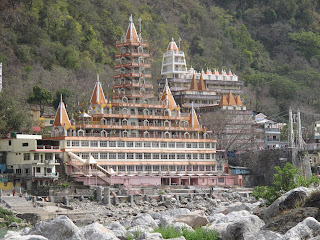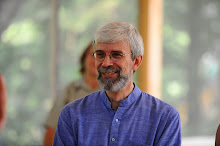I didn’t think anything could really persuade me really to like Indian cities. In my experience they are noisy, dirty, and frenetic. Each may have its charms or interests, to be sure, but overall …. Then I came to Delhi. One of the oldest continually inhabited cities in the world, Delhi has gone through many changes. I’ve had just a brief encounter of the old and new cities with an expectation of several more days later in my trip.
The flight from Trivandrum was tedious. I’d had to get up around 3:00 a.m. to make my way from Kollam to the airport in time. Jet Airways made a stopover in Bengalaru, meaning that I had my knees pressed firmly into the back of the seat in front of me for just over four hours. Like other carriers these days, they require you to pay for the “refreshments” that come around. Once landed, however, all resentment was gone as I entered the enormous, modern domestic terminal of the Indira Ghandi International Airport. My ride to the hotel was on hand and we sped off down the highway into the city. Driving in India is worth a separate account of its own. See the relevant blog.
I’d come to India prepared for the almost tropical climate of the South. Delhi was rather cooler, with temperatures in the teens. No more sandals and t-shirts for a while! My hotel was located in what seemed to be a major shopping area for clothes, so after unpacking, I went out to find some sweater or jacket. I’m not an enthusiastic clothes shopper at the best of times, so the array of choices was almost too much to bear. Store succeeded store along the streets. In front of most of them were yet further stalls offering marked down versions of what was inside. There was everything from the most sumptuous wedding garments for brides and grooms (at least in India the groom can look just about as resplendent as the bride. What’s more, he gets to show up at the wedding on horseback) to the latest Levi and Gap products. I bought an unimaginative sweater and then just wandered the streets, taking in the sights and sounds.



The next morning I had arranged for a driver and guide in order to maximize the time. It was probably lucky that it was Sunday. Traffic and crowds were less than usual. Going by the Red Fort, we went to the Jama Masjid, or Friday mosque, built between 1644 and 1658. This is the third largest mosque in the world, following the one in Mecca (not one I’ll ever get to see), and the Blue Mosque in Istanbul. It can hold a staggering 25,000 people. You exchange your shoes at the entrance for some white slippers. Women are given a kind of voluminous, padded nightgown which covers them from neck to foot. The mosque’s design incorporates clues about Shah Jahan’s religiously tolerant views. The domes include the lotus flower, symbol of Hindu religion.
 |
Jama Masjid
|
I decided to climb the narrow, winding staircase up the southern minaret. 121 steps later I had a magnificent view of the city. It was well worth the climb. On the main level, the white and black marble inlay of the floor sets out the precise space for prayer mats. The architect wisely provided spots for those who are either extra-long or extra-wide. Would that airlines could be as prescient!
 |
| Places for Prayer Mats |
 |
| At Prayer |
From the mosque I took a bicycle rickshaw through the narrow streets of old Delhi. I imagine only someone born and raised there could ever really come to know the way around. The streets we took were narrow enough, but running off them was a spider web of still smaller lanes and alleys, disappearing into shadows and turnings. Overhead was another web of wires, either an electrician’s nightmare or an ingenious, if dubious-looking solution to providing power to every part of the lattice-work of streets.
 |
| Electrician's Nightmare |
 |
| Gandhi Memorial |
From the tangle of old Delhi’s streets, we sped down the Rajpath or King’s Way. I’d seen this imposing boulevard on television where the country’s Republic Day celebrations made full use of its grand design. The English architect Edward Lutyens designed and built New Delhi between 1914 and 1931 when the British moved their capital from Calcutta. The design was intended to be a monument in stone to the British Raj. In the event, the British were gone by 1947 but the new republic has made the most of Lutyen’s work. The departure of the British was brought about in large measure by Mohandas K. Ghandi, the Mahatma. His memorial is eloquent in its simplicity, a fitting tribute to his own ability to speak truth peacefully to power.
The Rashtrapati Bhavan or President’s House used to be home to the Viceroy of India. Apparently Earl Mountbatten employed hundreds of servants, including fifty boys whose task was to scare away birds from the gardens. There was no sign of any such servants, but bands of roaming monkeys seemed to have taken their places.
 |
| Presidential Palace |
 |
| Monkey Patrol |
After doing some shopping for gifts for people back home, my guide dropped me off at a restaurant for some lunch. This was a place offering “mixed” cuisine, i.e., served Western as well as Indian food. I can never seem to convince people here that I really do like, even prefer, Indian food , and the spicier the better. To get to the washroom, I had to pass from the main dining area through a section that was almost stygian in darkness, dominated by loud, pulsing techno-music. I could dimly discern young couples sitting in booths around this area, snogging furiously. I expect the music and especially the darkness are the draw for those who would not otherwise be able to engage in such public displays of affection. Even married couples do not embrace or hold hands in this conservative culture.
 |
| Humayun's Tomb |
The highlight of the tour after lunch was Humayun’s Tomb. The tomb was built in the early 16th century by Haji Begum, the Persian-born wife of the second Moghul emperor, Humayun. The design is a kind of proto-Taj Mahal, but it possesses its own striking beauty. Red sandstone and white marble combine to form a squat building with a bulbous dome. The tomb area is found on the upper level, reached by high, steep steps. Light filters in through high, arched entrances and latticed windows. There are several other tombs within the precinct, including one of Haji Begum herself. The lawns, trees, and fountains around the tombs provide a restful, well-proportioned, and pleasing park. Truly, a beautiful place.
 |
| Dome above the tomb |
 |
| Floor detail |
 |
| Couple visiting the tomb |
 |
| Not just your usual walk in the park |
This is a brief account of a brief visit in which the city revealed some of its most attractive features to me. I plan to be back towards the end of March before going home. I’ll look forward to seeing more of this great city, as well as having a tour of some of its sad and difficult slum areas, for the reality of Delhi includes both.































































